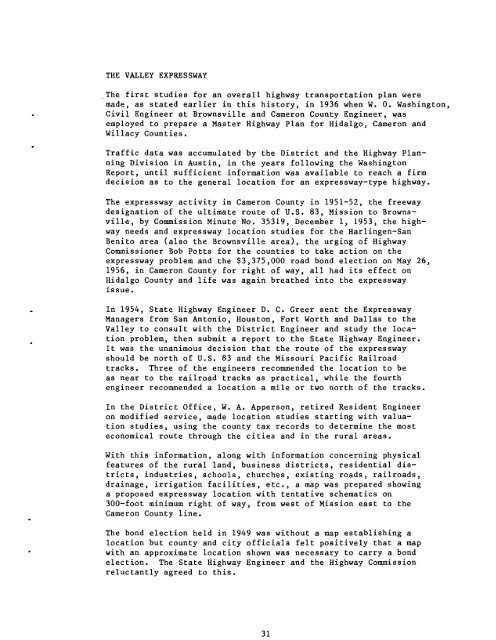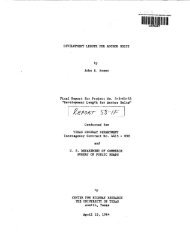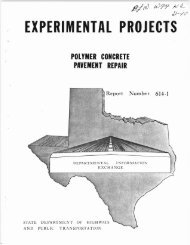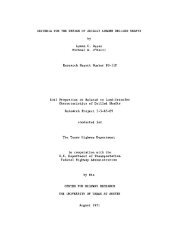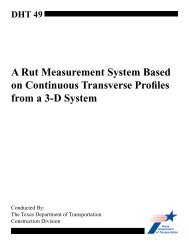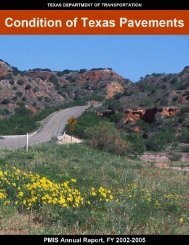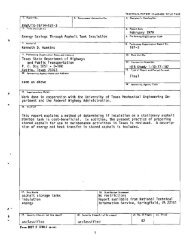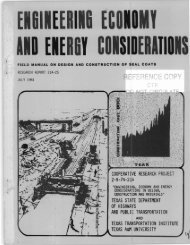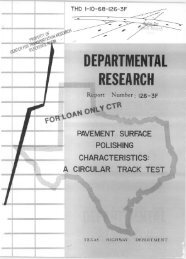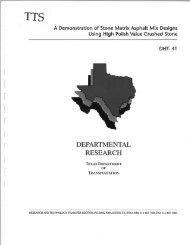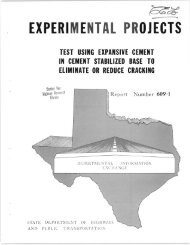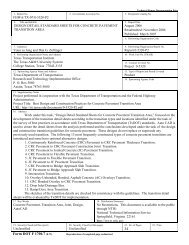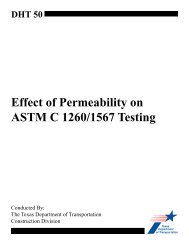HISTORY OF THE TEXAS HIGHWAY DEPARTMENT ... - CTR Library
HISTORY OF THE TEXAS HIGHWAY DEPARTMENT ... - CTR Library
HISTORY OF THE TEXAS HIGHWAY DEPARTMENT ... - CTR Library
Create successful ePaper yourself
Turn your PDF publications into a flip-book with our unique Google optimized e-Paper software.
<strong>THE</strong> VALLEY EXPRESSWAY<br />
The first studies for an overall highway transportation plan were<br />
made, as stated earlier in this history, in 1936 when W. O. Washington,<br />
Civil Engineer at Brownsville and Cameron County Engineer, was<br />
employed to prepare a Master Highway Plan for Hidalgo, Cameron and<br />
Willacy Counties.<br />
Traffic data was accumulated by the District and the Highway Planning<br />
Division in Austin, in the years following the Washington<br />
Report, until sufficient information was available to reach a firm<br />
decision as to the general location for an expressway-type highway.<br />
The expressway activity in Cameron County in 1951-52, the freeway<br />
designation of the ultimate route of U.S. 83, Mission to Brownsville,<br />
by Commission Minute No. 35319, December 1, 1953, the highway<br />
needs and expressway location studies for the Harlingen-San<br />
Benito area (also the Brownsville area), the urging of Highway<br />
Commissioner Bob Potts for the counties to take action on the<br />
expressway problem and the $3,375,000 road bond election on May 26,<br />
1956, in Cameron County for right of way, all had its effect on<br />
Hidalgo County and life was again breathed into the expressway<br />
issue.<br />
In 1954, State Highway Engineer D. C. Greer sent the Expressway<br />
Managers from San Antonio, Houston, Fort Worth and Dallas to the<br />
Valley to consult with the District Engineer and study the location<br />
problem, then submit a report to the State Highway Engineer.<br />
It was the unanimous decision that the route of the expressway<br />
should be north of U.S. 83 and the Missouri Pacific Railroad<br />
tracks. Three of the engineers recommended the location to be<br />
as near to the railroad tracks as practical, while the fourth<br />
engineer recommended a location a mile or two north of the tracks.<br />
In the District Office, W. A. Apperson, retired Resident Engineer<br />
on modified service, made location studies starting with valuation<br />
studies, using the county tax records to determine the most<br />
economical route through the cities and in the rural areas.<br />
With this information, along with information concerning physical<br />
features of the rural land, business districts, residential districts,<br />
industries, schools, churches, existing roads, railroads,<br />
drainage, irrigation facilities, etc., a map was prepared showing<br />
a proposed expressway location with tentative schematics on<br />
300-foot minimum right of way, from west of Mission east to the<br />
Cameron County line.<br />
The bond election held in 1949 was without a map establishing a<br />
location but county and city officials felt positively that a map<br />
with an approximate location shown was necessary to carry a bond<br />
election. The State Highway Engineer and the Highway Commission<br />
reluctantly agreed to this.<br />
31


